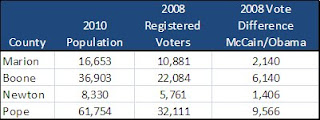Congressional Redistricting Review and Analysis
Every ten years states must realign internal political boundaries based on the recently completed census results. Last week, the United States Census Bureau released the results of the 2010 census for the state of Arkansas. This new data has brought redistricting to the forefront of political discussion as pundits and politicians alike begin analyzing the data and drawing lines on a map to see whom will have the advantage in the next general election in 2012.
There are two types of redistricting that will occur in 2011 – congressional and state legislative. Congressional redistricting relates to the four seats in the United States House of Representatives and state legislative refers to the 100 state representative and 35 state senator seats that make up the Arkansas General Assembly.
Congressional redistricting is the responsibility of the General Assembly where the State Agencies Committee of the House and Senate draft new boundaries for the four congressional seats and submit it to the General Assembly for consideration. Based on the 2010 Census each congressional district should have around 729,000. Since the General Assembly decides Congressional redistricting, the new boundaries must be drawn fairly quickly and approved before the General Assembly adjourns – probably in April.
State legislative redistricting is the responsibility of the Board of Apportionment, which consists of Governor Mike Beebe, Attorney General Dustin McDaniel, and Secretary of State Mark Martin. I will provide additional insight on state legislative redistricting later in the week. This blog post will focus on the congressional redistricting.
The 2nd (Central) and 3rd (Northwest) Congressional Districts gained residents over the last ten years and will need to shrink geographically to fit under the approximate 729,000 population limit. The 3rd District must shed more than 93,000 people while the 2nd must move more than 22,000 into another district. The 4th (south) and 1st (east) require an additional 74,000 and 41,000, respectively.
So how does the General Assembly decide which voters move to a new district? This is the $64,000 question. The State Agencies Committee in the Senate is equally split between Democrats and Republicans while Democrats control the House State Agencies Committee. Whatever plan gets referred from the State Agencies Committee will have to be approved by the entire General Assembly, which is controlled by the Democrats so one would assume that they will be the ultimate arbitrators of final congressional lines. If this assumption is correct then the Democrats are facing some difficult decisions because all of the border counties that are likely to be moved to the 1st and 4th are pretty solid Republican territory.
So, let us start with the 4th Congressional District, which is the sole remaining Congressional seat held by a Democrat. Representative Mike Ross defeated his Republican opponent in 2010 by more than 30,000 votes. This healthy margin of victory provides a cushion for the Democrats to shift some of the stronger Republican counties from the 2nd and 3rd District and keep them out of 1st District, which is still a competitive district. Below is a list of the counties that seem likely candidates to shift from either the 2nd or 3rd District to the 4th District. The table also provides data on each county’s 2010 population, 2008 registered voters and the difference between votes for John McCain and Barack Obama during the 2008 Presidential election.
3rd District Border Counties possibly to 4th District
2nd District Counties possibly to 4th District
The 4th District needs to add around 74,000 people, so what counties might be shifted? Yell County jumps out as a safe move for the Democrats. It allows the 1st District to completely satisfy their required reduction in population and it only adds a net of 1,800 Republican votes to Mike Ross’s district. It also follows that shifting Johnson and Franklin counties to the 4th District from the 3rd would offer the best hope to Democrats of maintaining a majority in the 4th District by transferring 43,665 people out of the 3rd District, but adding a net of just 4,430 Republican votes to the 4th District. In total, moving these three counties to the 4th District almost satisfies the population shift required to equalize the 4th District while maintaining – on paper anyway – a Democratic Congressional seat and satisfying the 2nd District’s required population reduction.
With the 2nd District’s population reduction satisfied by moving Yell County to the 4th District, it will be up to the 3rd District to supply the required 41,000 people to the 1st District. The 1st Congressional District has historically been a Democrat stronghold until 2010 when Rick Crawford defeated Chad Causey by 15,000 votes. The 1st District appears to be the best hope for Democrats to regain a Congressional seat in 2012. This district also poses the most difficult redistricting challenge.
3rd District Counties Possibly to 1st District
The only scenario that seems to work geographically is to shift Marion and a majority of Boone County to the 1st District, which would add a net of 8,280 Republican votes to the 1st District. Marion fits fairly closely demographically and economically with Baxter County so that move would make sense. Boone County, on the other hand, has a long tradition with the 3rd District since 3rd District legend Congressman John Paul Hammerschmidt’s hometown is Harrison.
The map below shows a potential new congressional redistricting based on this scenario.
This scenario reflects one approach Democrats in the General Assembly might consider if they want to try and protect the 4th District and keep the 1st District in play for 2012. It approximately satisfies all of the population requirements and keeps strong, heavily populated Republican counties in the 3rd and 2nd. Whether this is even remotely close to what comes out of the General Assembly is any one’s guess.




